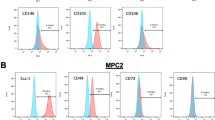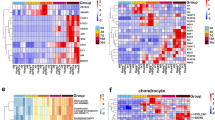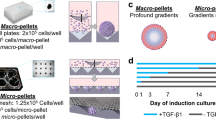Abstract
Current protocols for the differentiation of human pluripotent stem cells (hPSCs) into chondrocytes do not allow for the expansion of intermediate progenitors so as to prospectively assess their chondrogenic potential. Here we report a protocol that leverages PRRX1–tdTomato reporter hPSCs for the selective induction of expandable and ontogenetically defined PRRX1+ limb-bud-like mesenchymal cells under defined xeno-free conditions, and the prospective assessment of the cells’ chondrogenic potential via the cell-surface markers CD90, CD140B and CD82. The cells, which proliferated stably and exhibited the potential to undergo chondrogenic differentiation, formed hyaline cartilaginous-like tissue commensurate to their PRRX1-expression levels. Moreover, we show that limb-bud-like mesenchymal cells derived from patient-derived induced hPSCs can be used to identify therapeutic candidates for type II collagenopathy and we developed a method to generate uniformly sized hyaline cartilaginous-like particles by plating the cells on culture dishes coated with spots of a zwitterionic polymer. PRRX1+ limb-bud-like mesenchymal cells could facilitate the mass production of chondrocytes and cartilaginous tissues for applications in drug screening and tissue engineering.
This is a preview of subscription content, access via your institution
Access options
Access Nature and 54 other Nature Portfolio journals
Get Nature+, our best-value online-access subscription
$29.99 / 30 days
cancel any time
Subscribe to this journal
Receive 12 digital issues and online access to articles
$99.00 per year
only $8.25 per issue
Buy this article
- Purchase on Springer Link
- Instant access to full article PDF
Prices may be subject to local taxes which are calculated during checkout






Similar content being viewed by others
Data availability
The main data supporting the results in this study are available within the paper and its Supplementary Information. The raw and processed RNA-seq data were deposited in the NCBI GEO database under the accession number GSE165620. All data generated in this study, including source data and the data used to make the figures, are available from figshare with the identifier https://doi.org/10.6084/m9.figshare.14888937. Source data are provided with this paper.
References
Tam, W. L., Luyten, F. P. & Roberts, S. J. From skeletal development to the creation of pluripotent stem cell-derived bone-forming progenitors. Phil. Trans. R. Soc. B https://doi.org/10.1098/rstb.2017.0218 (2018).
Berendsen, A. D. & Olsen, B. R. Bone development. Bone 80, 14–18 (2015).
Kawata, M. et al. Simple and robust differentiation of human pluripotent stem cells toward chondrocytes by two small-molecule compounds. Stem Cell Rep. 13, 530–544 (2019).
Yamashita, A. et al. Generation of scaffoldless hyaline cartilaginous tissue from human iPSCs. Stem Cell Rep. 4, 404–418 (2015).
Craft, A. M. et al. Generation of articular chondrocytes from human pluripotent stem cells. Nat. Biotechnol. 33, 638–645 (2015).
Umeda, K. et al. Long-term expandable SOX9+ chondrogenic ectomesenchymal cells from human pluripotent stem cells. Stem. Cell Rep. 4, 712–726 (2015).
Nakajima, T. et al. Modeling human somite development and fibrodysplasia ossificans progressiva with induced pluripotent stem cells. Development https://doi.org/10.1242/dev.165431 (2018).
Tanaka, M. Molecular and evolutionary basis of limb field specification and limb initiation. Dev. Growth Differ. 55, 149–163 (2013).
Pignatti, E., Zeller, R. & Zuniga, A. To BMP or not to BMP during vertebrate limb bud development. Semin. Cell Dev. Biol. 32, 119–127 (2014).
Yu, K. & Ornitz, D. M. FGF signaling regulates mesenchymal differentiation and skeletal patterning along the limb bud proximodistal axis. Development 135, 483–491 (2008).
Lewandowski, J. P. et al. Spatiotemporal regulation of GLI target genes in the mammalian limb bud. Dev. Biol. 406, 92–103 (2015).
Taher, L. et al. Global gene expression analysis of murine limb development. PLoS ONE https://doi.org/10.1371/journal.pone.0028358 (2011).
Martin, J. F., Bradley, A. & Olson, E. N. The paired-like homeo box gene MHox is required for early events of skeletogenesis in multiple lineages. Genes Dev. 9, 1237–1249 (1995).
ten Berge, D. et al. Prx1 and Prx2 are upstream regulators of sonic hedgehog and control cell proliferation during mandibular arch morphogenesis. Development 128, 2929–2938 (2001).
Dasouki, M., Andrews, B., Parimi, P. & Kamnasaran, D. Recurrent agnathia-otocephaly caused by DNA replication slippage in PRRX1. Am. J. Med. Genet. A 161A, 803–808 (2013).
Conway, S. J., Henderson, D. J. & Copp, A. J. Pax3 is required for cardiac neural crest migration in the mouse: evidence from the splotch (Sp2H) mutant. Development 124, 505–514 (1997).
Akiyama, H. et al. Osteo-chondroprogenitor cells are derived from Sox9 expressing precursors. Proc. Natl Acad. Sci. USA 102, 14665–14670 (2005).
Takarada, T. et al. Genetic analysis of Runx2 function during intramembranous ossification. Development 143, 211–218 (2016).
Durland, J. L., Sferlazzo, M., Logan, M. & Burke, A. C. Visualizing the lateral somitic frontier in the Prx1Cre transgenic mouse. J. Anat. 212, 590–602 (2008).
Karamboulas, K., Dranse, H. J. & Underhill, T. M. Regulation of BMP-dependent chondrogenesis in early limb mesenchyme by TGFβ signals. J. Cell Sci. 123, 2068–2076 (2010).
Tam, P. P. & Beddington, R. S. The formation of mesodermal tissues in the mouse embryo during gastrulation and early organogenesis. Development 99, 109–126 (1987).
Lawson, K. A., Meneses, J. J. & Pedersen, R. A. Clonal analysis of epiblast fate during germ layer formation in the mouse embryo. Development 113, 891–911 (1991).
Loh, K. M. et al. Mapping the pairwise choices leading from pluripotency to human bone, heart, and other mesoderm cell types. Cell 166, 451–467 (2016).
ten Berge, D., Brugmann, S. A., Helms, J. A. & Nusse, R. Wnt and FGF signals interact to coordinate growth with cell fate specification during limb development. Development 135, 3247–3257 (2008).
Hill, T. P., Taketo, M. M., Birchmeier, W. & Hartmann, C. Multiple roles of mesenchymal β-catenin during murine limb patterning. Development 133, 1219–1229 (2006).
Michos, O. et al. Gremlin-mediated BMP antagonism induces the epithelial–mesenchymal feedback signaling controlling metanephric kidney and limb organogenesis. Development 131, 3401–3410 (2004).
Stott, N. S. & Chuong, C. M. Dual action of sonic hedgehog on chondrocyte hypertrophy: retrovirus mediated ectopic sonic hedgehog expression in limb bud micromass culture induces cartilage nodules that are positive for alkaline phosphatase and type X collagen. J. Cell Sci. 110, 2691–2701 (1997).
Fernandez-Teran, M., Piedra, M. E., Rodriguez-Rey, J. C., Talamillo, A. & Ros, M. A. Expression and regulation of eHAND during limb development. Dev. Dyn. 226, 690–701 (2003).
Mahlapuu, M., Ormestad, M., Enerback, S. & Carlsson, P. The forkhead transcription factor Foxf1 is required for differentiation of extra-embryonic and lateral plate mesoderm. Development 128, 155–166 (2001).
Yang, L. et al. Isl1Cre reveals a common Bmp pathway in heart and limb development. Development 133, 1575–1585 (2006).
Okada, M. et al. Modeling type II collagenopathy skeletal dysplasia by directed conversion and induced pluripotent stem cells. Hum. Mol. Genet. 24, 299–313 (2015).
Mortier, G. R. et al. Nosology and classification of genetic skeletal disorders: 2019 revision. Am. J. Med. Genet. A 179, 2393–2419 (2019).
Ala-Kokko, L., Baldwin, C. T., Moskowitz, R. W. & Prockop, D. J. Single base mutation in the type II procollagen gene (COL2A1) as a cause of primary osteoarthritis associated with a mild chondrodysplasia. Proc. Natl Acad. Sci. USA 87, 6565–6568 (1990).
Iwai, R., Nemoto, Y. & Nakayama, Y. The effect of electrically charged polyion complex nanoparticle-coated surfaces on adipose-derived stromal progenitor cell behaviour. Biomaterials 34, 9096–9102 (2013).
Iwai, R., Nemoto, Y. & Nakayama, Y. Preparation and characterization of directed, one-day-self-assembled millimeter-size spheroids of adipose-derived mesenchymal stem cells. J. Biomed. Mater. Res. A 104, 305–312 (2016).
Iwai, R., Haruki, R., Nemoto, Y. & Nakayama, Y. Induction of cell self-organization on weakly positively charged surfaces prepared by the deposition of polyion complex nanoparticles of thermoresponsive, zwitterionic copolymers. J. Biomed. Mater. Res. B 105, 1009–1015 (2017).
Schneider, V. A. & Mercola, M. Wnt antagonism initiates cardiogenesis in Xenopus laevis. Genes Dev. 15, 304–315 (2001).
Mori, S. et al. Self-organized formation of developing appendages from murine pluripotent stem cells. Nat. Commun. 10, 3802 (2019).
Chen, Y., Xu, H. & Lin, G. Generation of iPSC-derived limb progenitor-like cells for stimulating phalange regeneration in the adult mouse. Cell Discov. 3, 17046 (2017).
Skinner, M. K. Role of epigenetics in developmental biology and transgenerational inheritance. Birth Defects Res. C 93, 51–55 (2011).
Mohammad, H. P., Barbash, O. & Creasy, C. L. Targeting epigenetic modifications in cancer therapy: erasing the roadmap to cancer. Nat. Med. 25, 403–418 (2019).
Mazzone, R. et al. The emerging role of epigenetics in human autoimmune disorders. Clin. Epigenetics 11, 34 (2019).
Feinberg, A. P. The key role of epigenetics in human disease prevention and mitigation. N. Engl. J. Med. 378, 1323–1334 (2018).
Jarrell, D. K., Lennon, M. L. & Jacot, J. G. Epigenetics and mechanobiology in heart development and congenital heart disease. Diseases https://doi.org/10.3390/diseases7030052 (2019).
Lin, P. P. et al. Targeted mutation of p53 and Rb in mesenchymal cells of the limb bud produces sarcomas in mice. Carcinogenesis 30, 1789–1795 (2009).
Quist, T. et al. The impact of osteoblastic differentiation on osteosarcomagenesis in the mouse. Oncogene 34, 4278–4284 (2015).
Lee, J. Y. et al. Pre-transplantational control of the post-transplantational fate of human pluripotent stem cell-derived cartilage. Stem Cell Rep. 11, 440–453 (2018).
Reinisch, A. et al. Epigenetic and in vivo comparison of diverse MSC sources reveals an endochondral signature for human hematopoietic niche formation. Blood 125, 249–260 (2015).
Chamberlain, G., Fox, J., Ashton, B. & Middleton, J. Concise review: mesenchymal stem cells: their phenotype, differentiation capacity, immunological features, and potential for homing. Stem Cells 25, 2739–2749 (2007).
Kim, M. et al. Donor variation and optimization of human mesenchymal stem cell chondrogenesis in hyaluronic acid. Tissue Eng. A 24, 1693–1703 (2018).
Garcia, J. et al. Chondrogenic potency analyses of donor-Matched chondrocytes and mesenchymal stem cells derived from bone marrow, infrapatellar fat pad, and subcutaneous fat. Stem Cells Int. 2016, 6969726 (2016).
Payne, K. A., Didiano, D. M. & Chu, C. R. Donor sex and age influence the chondrogenic potential of human femoral bone marrow stem cells. Osteoarthr. Cartil. 18, 705–713 (2010).
Acknowledgements
We thank N. Tsumaki for providing iPS cell lines derived from patients with COL2pathy (ACGII-1 and HCG-1); M. Hada and M. Nishio for technical assistance with feeder-free cultures; A. Hirao for providing chemical libraries; and K. Sekiguchi, S. Nagata, S. Tamaki, Y. Jin and C. Alev for their invaluable comments and advice. Preparation of slides and staining was supported by the Central Research Laboratory, Okayama University Medical School. We thank the members of the Department of Animal Resources, Advanced Science Research Center and Okayama University for maintaining the mice. This research was supported by Grants-in-aid for Scientific Research from the Japan Society for the Promotion of Science (grant no. 17H04399 to T. Takarada), AMED (grant nos 18bm0704024h0001 and 20bm0404064h0001 to T. Takarada), the Acceleration Program for Intractable Disease Research Utilizing Disease Specific iPS Cells (AMED) to J.T. and the Cooperative Research Program (Joint Usage/Research Center program) of the Institute for Frontier Life and Medical Sciences, Kyoto University to T. Takarada and J.T. These funders had no role in the study design, data collection and analysis, decision to publish or preparation of the manuscript.
Author information
Authors and Affiliations
Contributions
D.Y. performed the experiments, analysed the data and wrote the manuscript. M.N., T. Takao, S.T., A.Y., S.K., A.M. and L.M. performed the experiments. H.Y., M.G., K.O., N.K. and T. Takarada provided critical materials. H.H., R.I., E.N., T.O. and J.T. discussed the data and provided critical advice. T. Takarada supervised the project and wrote the manuscript.
Corresponding author
Ethics declarations
Competing interests
The authors declare no competing interests.
Additional information
Peer review information Nature Biomedical Engineering thanks Shuibing Chen and the other, anonymous, reviewer(s) for their contribution to the peer review of this work. Peer reviewer reports are available.
Publisher’s note Springer Nature remains neutral with regard to jurisdictional claims in published maps and institutional affiliations.
Extended data
Extended Data Fig. 1 Immunostaining of PRRX1 in human pluripotent stem cells on pluripotency (day 0) or in the PRRX1+ state.
Immunostaining of PRRX1 in hiPSC lines (414C2 and 1383D2) or hESC lines SEES4 and SEES5 at days 0 and 4.
Extended Data Fig. 2 Engraftment of cartilaginous particles in damaged articular cartilage of SCID rats.
A 1-mm drill hole defect was formed in the articular cartilage of SCID rats and then PRRX13´tdTomato-reporter-derived cartilaginous particles were embedded. The knee joints were fixed 4 weeks after transplantation and tissue sections were stained with HE, Toluidine blue or human VIMENTIN. Representative images were shown.
Extended Data Fig. 3 Bone-like-tissue forming capacity of ExpLBM cells.
(a-c) Human bone marrow-derived mesenchymal stem cell (BM-hMSC) or ExpLBM cells were suspended with βTCP and subcutaneously transplanted into NOD-SCID mice. After 8 weeks, mice were sacrificed and tissues were isolated to identify histological differences using HE staining (a), trichrome staining (b) and immunostaining with human VIMENTIN/COLX (c).
Extended Data Fig. 4 Abnormal chondrogenic capacity of ACGII-1- and HCG-1-derived ExpLBM cells.
(a) Alcian blue staining of other ACGII-1 or HCG-1 clone-derived ExpLBM cells after 2DCI. Other clones established from the same patient were induced to ExpLBM cells and their chondrogenic potentials were assessed by Alcian blue staining after 2DCI (n = 3, three biologically independent experiments). (b) Histological analysis of the cartilaginous particles generated using 3DCI. The cartilaginous particles were generated from each ExpLBM cell. Particle sections were stained with HE, Alcian blue or Safranin O or with antibodies against SOX9, COL2, COL1 or COLX. (c) Measurements and comparison of Safranin O-, SOX9-, or COL2-stained areas in Extended Data Fig. 5b (n = 3, three biologically independent experiments). (d) RT–qPCR analysis of the expression of chondrocyte marker genes after 3DCI using cartilaginous particles derived from each ExpLBM cell. All the values were normalized to the ACTB mRNA levels (n = 3, three biologically independent experiments). *P < 0.05, **P < 0.01, ***P < 0.001. Statistical significance was determined by one-way ANOVA with correction for multiple testing using the Bonferroni method (a, c, d).
Extended Data Fig. 5 Transmission electron microscopy of cartilaginous particles of each ExpLBM cell on day 42 of step 3.
Cartilaginous particles of COL2pathy-ExpLBM cells comprise chondrocytes with a distended endoplasmic reticulum and low abundance of glycogen. Arrows and arrowheads indicate the endoplasmic reticulum (ER) and glycogen, respectively.
Supplementary information
Source data
Source data for Fig. 1
Unprocessed gels.
Source data for Fig. 1
Source data.
Source data for Fig. 3
Source data.
Source data for Fig. 4
Source data.
Source data for Fig. 5
Source data.
Source data for Extended Data Fig. 4
Source data.
Rights and permissions
About this article
Cite this article
Yamada, D., Nakamura, M., Takao, T. et al. Induction and expansion of human PRRX1+ limb-bud-like mesenchymal cells from pluripotent stem cells. Nat Biomed Eng 5, 926–940 (2021). https://doi.org/10.1038/s41551-021-00778-x
Received:
Accepted:
Published:
Issue Date:
DOI: https://doi.org/10.1038/s41551-021-00778-x
This article is cited by
-
Effect of a retinoic acid analogue on BMP-driven pluripotent stem cell chondrogenesis
Scientific Reports (2024)
-
Comparison studies identify mesenchymal stromal cells with potent regenerative activity in osteoarthritis treatment
npj Regenerative Medicine (2024)
-
PRRX1-TOP2A interaction is a malignancy-promoting factor in human malignant peripheral nerve sheath tumours
British Journal of Cancer (2024)
-
A novel chondrocyte sheet fabrication using human-induced pluripotent stem cell-derived expandable limb-bud mesenchymal cells
Stem Cell Research & Therapy (2023)
-
3D osteogenic differentiation of human iPSCs reveals the role of TGFβ signal in the transition from progenitors to osteoblasts and osteoblasts to osteocytes
Scientific Reports (2023)



